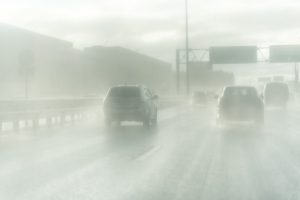 If you’ve never hydroplaned, consider yourself lucky. It’s a pretty scary feeling, when you realize that the car is moving and you can’t control where it goes.
If you’ve never hydroplaned, consider yourself lucky. It’s a pretty scary feeling, when you realize that the car is moving and you can’t control where it goes.
Cars are likely to hydroplane when there’s a severe storm, a hurricane, or any event that produces a lot of water on the roads. Cars that hydroplane are sometimes damaged beyond repair, and drivers and passengers can be put at risk of serious injuries in a crash.
Hydroplaning Do’s and Don’ts
Hydroplaning means that the car’s front tires lose tractions According to DefensiveDriving.com, a company that offers online defensive driving courses, drivers should consider the following safety tips and precautions to reduce the risk of injury and property damage from hydroplaning:
The Don’ts
- Don’t panic. Your first instinct might be to panic, but try to stay calm.
- Don’t slam on the brakes. Quick braking may slow down the front tires but it often locks the rear tires. Hitting the brakes will increase the level of hydroplaning. Slamming on the brakes can cause your car to spin out of control.
- Don’t accelerate quickly. Fast acceleration forces the car to go straight, which isn’t good if the car is in a curve.
- Don’t use cruise control. If it’s raining hard, it’s better to turn off your cruise control. If you use cruise control, the water accumulation may cause your car to shift to a lower gear – which could cause even more water to accumulate and a car accident to occur.
The Dos
- Drivers should know where their drive wheels are. Drive wheels are either in the front or the rear. A local dealer, a mechanic, or your vehicle manual can inform you if you’re not sure.
- If you have front-wheel drive that has traction control and has an ABS (anti-lock braking system), then you should drive into an open area in the lane that’s in front of your or on the side of the highway. The hydroplaning should be short in time and in distance. Drivers should push lightly on the car accelerator as the car heads toward the open space which gives your car time to respond to the new driving surface.
- If you have rear-wheel drive that doesn’t have traction control or an anti-lock braking system, you still need to look for some open territory where you can properly respond. Instead of pushing the accelerator, you want to ease off the accelerator. Ideally, you won’t need to come to a full stop. If you have to stop, be prepared to pull off to the side of the road. You should then activate your emergency flashers.
It’s good practice to check the tread on your tire for thickness. Worn tires are dangerous tires. Tires should be properly inflated so they don’t increase the stopping distance. The user manual should indicate the proper tire pressure. It helps if you’re not going too fast when it starts to rain or if the road surfaces are wet.
At the Rocky McElhaney Law Firm, we represent passengers, drivers, pedestrians, and bystanders. Whatever the cause of the accident, we have the team that can help you hold careless drivers responsible for the injuries they cause. We work with investigators and the police to determine what happened. Our team examines the accident site, the vehicles witnesses, and the parties. To get justice for your injuries, call our trial lawyers at 615-246-5549 or use our contact form to schedule an appointment. We represent clients in Nashville, Hendersonville, Knoxville and across Tennessee.
.
